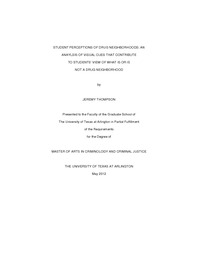| dc.contributor.author | Thompson, Jeremy | en_US |
| dc.date.accessioned | 2012-07-25T19:08:36Z | |
| dc.date.available | 2012-07-25T19:08:36Z | |
| dc.date.issued | 2012-07-25 | |
| dc.date.submitted | January 2012 | en_US |
| dc.identifier.other | DISS-11585 | en_US |
| dc.identifier.uri | http://hdl.handle.net/10106/11050 | |
| dc.description.abstract | Perceptions of crime has been an emerging criminological area of study for the past twenty years. Prior research has shown that visual cues of social disorganization are indicators of both general crime and narcotics crime. This research explores perceptions of narcotics crimes through the utilization of a cross-sectional quantitative research method. Data collected through this study was analyzed by a series of tests which confirm prior findings regarding the connection between visual cues of social disorganization and the perception of crime. This study further suggests that visual indicators of crime have the greatest impact on women, Asian or Pacific Islanders, people who are more familiar with the criminal justice system, or have an overall concern about crime. | en_US |
| dc.description.sponsorship | Bing, Robert | en_US |
| dc.language.iso | en | en_US |
| dc.publisher | Criminology & Criminal Justice | en_US |
| dc.title | Student Perceptions Of Drug Neighborhoods: An Analysis Of Visual Cues That Contribute To Students' View Of What Is Or Is Not A Drug Neighborhood | en_US |
| dc.type | M.A. | en_US |
| dc.contributor.committeeChair | Bing, Robert | en_US |
| dc.degree.department | Criminology & Criminal Justice | en_US |
| dc.degree.discipline | Criminology & Criminal Justice | en_US |
| dc.degree.grantor | University of Texas at Arlington | en_US |
| dc.degree.level | masters | en_US |
| dc.degree.name | M.A. | en_US |

